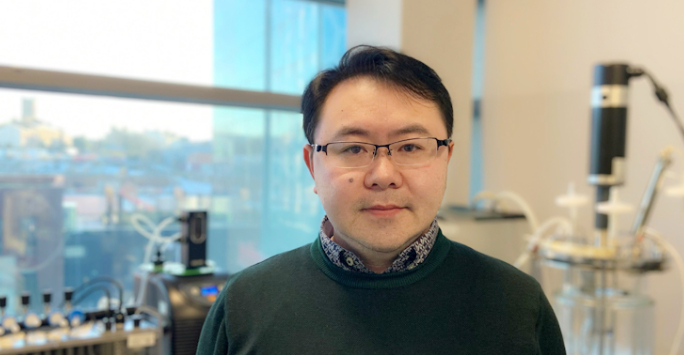
This edition of Spotlight focuses on Professor Luning Liu, Chair of Microbial Bioenergetics and Bioengineering in the Department of Biochemistry, Cell and Systems Biology. Having joined the University of Liverpool in December 2012, Luning was awarded a prestigious Royal Society University Research Fellowship to establish his independent research group, which focuses on photosynthesis, carbon fixation, and synthetic engineering.
The challenge
Climate change poses a significant threat to global agriculture, food and energy production, and public health. A contributor to global warming is the greenhouse gas carbon dioxide. In nature, plants and other organisms (known as phototrophic organisms) can collect carbon dioxide from the atmosphere and convert it into oxygen. As a result, establishing efficient ways for exploiting and improving photosynthesis is viewed as one way in which we could combat climate change.
Photosynthetic machinery is a complex puzzle of many parts that come together. These building blocks, or modules, have a remarkable ability to self-assemble to form a whole system and control how they work. Understanding self-assembly in nature is crucial not only to improving photosynthesis to help plants grow better, but to create new machinery and biomaterials for a variety of biotechnological applications.
Research in focus
Professor Luning Liu's group, the Liu Lab, aims to explore the intricate workings of biological machinery and membranes at the molecular level. They use a multidisciplinary approach, employing techniques such as molecular genetics, microbiology, biochemistry, proteomics, biophysics, and synthetic biology.
Emerging questions to be addressed include:
- How does nature develop functional machineries to enhance cellular metabolism?
- How do the structures of biological machineries ensure their physiological functions?
- How are the structure and function of the machineries regulated in response to the changing environment?
Bacterial microcompartments
Bacterial microcompartments are tiny cellular ‘protein containers’ found in many types of bacteria. They help to organise enzymes and keep them separate from the rest of the cell through a selectively permeable shell and play important roles in carbon fixation, disease, and microbial ecology.
The group’s research has provided unprecedented insights into how carboxysomes form from cyanobacteria and metabolosomes from the pathogen Salmonella enterica. Their studies have advanced our understanding of the structural principles of bacterial organelles and informed strategies to engineer functional organelles in non-native hosts for metabolic improvement.
Photosynthetic machinery and membranes
The group has pioneered the direct visualisation of the native structures, mobility, and assembly of protein supercomplexes in photosynthetic membranes from cyanobacteria, purple bacteria, and algae. Knowledge and technology obtained from studies on photosynthetic membranes lay the foundation for studies of many other biological membranes, such as plant chloroplast and mitochondrial membranes.
Their goal is to unravel the mysteries in the development of natural biological machinery. Addressing this knowledge gap will allow the team to underpin synthetic engineering of new biological “devices” and promote biotechnological and biomedical applications. Their research is funded by the UK Royal Society, BBSRC, EPSRC, Leverhulme Trust, and Medical Research Council.